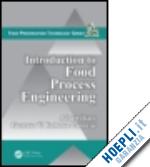Consumer expectations are systematically growing, with demands for foods with a number of attributes, which are sometimes difficult for manufacturers to meet. The engineering processes that are needed to obtain top-quality foods are a major challenge due to the diversity of raw materials, intermediates, and final products. As in any other enterprise, the food industry must optimize each of the steps in the production chain to attain the best possible results. There is no question that a very important aspect to take into consideration when developing a process, designing a food factory, or modifying existing facilities is the in-depth knowledge of the basic engineering aspects involved in a given project. Introduction to Food Process Engineering covers the fundamental principles necessary to study, understand, and analyze most unit operations in the food engineering domain. It was conceived with two clear objectives in mind: 1) to present all of the subjects in a systematic, coherent, and sequential fashion in order to provide an excellent knowledge base for a number of conventional and unconventional processes encountered in food industry processing lines, as well as novel processes at the research and development stages; 2) to be the best grounding possible for another CRC Press publication, Unit Operations in Food Engineering, Second Edition, by the same authors. These two books can be consulted independently, but at the same time, there is a significant and welcomed match between the two in terms of terminology, definitions, units, symbols, and nomenclature. Highlights of the book include: Dimensional analysis and similarities Physicochemistry of food systems Heat and mass transfer in food Food rheology Physical properties Water activity Thermal processing Chilling and freezing Evaporation Dehydration Extensive examples, problems, and solutions











